One Year of Lifting
Disclaimer: I am not a qualified health or fitness professional. This post is about my experience and is not a research paper or medical standard.
Before 2020 I had never used weights or machines in a gym. More than one person in college struck up a conversation about lifting together, but I always had reasons not to join them. I was tired from classes. From running long distance. From working.
I was actually anxious about the gym, and I didn’t accept it at the time. The unspoken etiquette and technique of how to use the weights and machines overwhelmed me. A similar paralysis hit me when I first started going to a grocery store for myself. I overthought the position of my cart in the aisle. I overthought the time I spent at the pasta shelf and the veggie bin. I overthought how I spoke to the attendant, the bagger, and anyone I accidentally delayed in the store.
The daily need for food, however, forced me to learn and deal with the overthinking. Lifting did not have this urgency, so I avoided it. I kept running.
A promised challenge
The realization that I had been avoiding it out of fear, and nothing else, hit me like a wall during my last year of college. Surrounded by a pool of stress, heartbreak, and assignments, I promised myself: when I graduate, I will lift for at least one year.
I graduated in May 2020. A few months later I moved to Seattle to work for Microsoft and now had stable income to buy food and pay for a personal trainer. I knew a little about how to lift from my older brother, and that little was the importance of progressive overload and consistent form. I looked for a trainer who would push me on both.
Day zero
I booked a get-to-know-you session with Jake Wambaugh, a former linebacker for the University of Washington, former strength coach for Oregon State University, and a recent Master of Kinesiology. In that session he listened to my whole story, helped me figure out a plan, and passionately talked about the mechanics of movement. He was patient and explained what muscles were firing, why they were firing, how we should be moving them, how to watch out for our joints, and how to watch out for our central nervous system. I didn’t feel stupid for being new.
I decided to train with Jake, and I’m excited to share the progression.
Body
In my best running shape I weighed 150 pounds. With the end of college stress I ended up around 180, but I wasn’t too bothered. I also wasn’t trying to “get shredded” when I started lifting. I just wanted to learn how to move heavy stuff.
Moving heavy stuff is taxing, and I needed more food. I ate consistently and had one cheat meal each weekend.
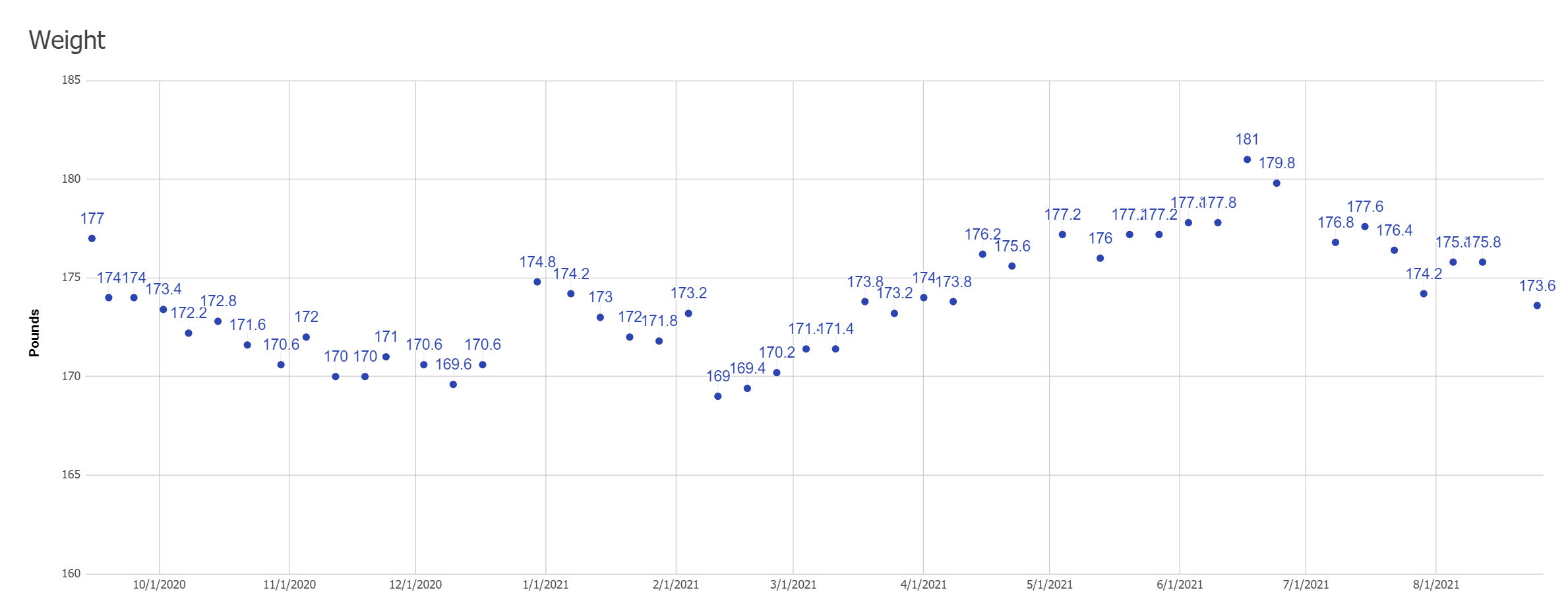
I ate around “maintenance” until February, which is when I decided to bulk. By the end of June I capped at a weight of 181. After that I did a cut for summer and landed at 173. The thing that blew my mind was I’d hit similar weights and be a completely different body composition. The number didn’t matter — what I could do with it did.
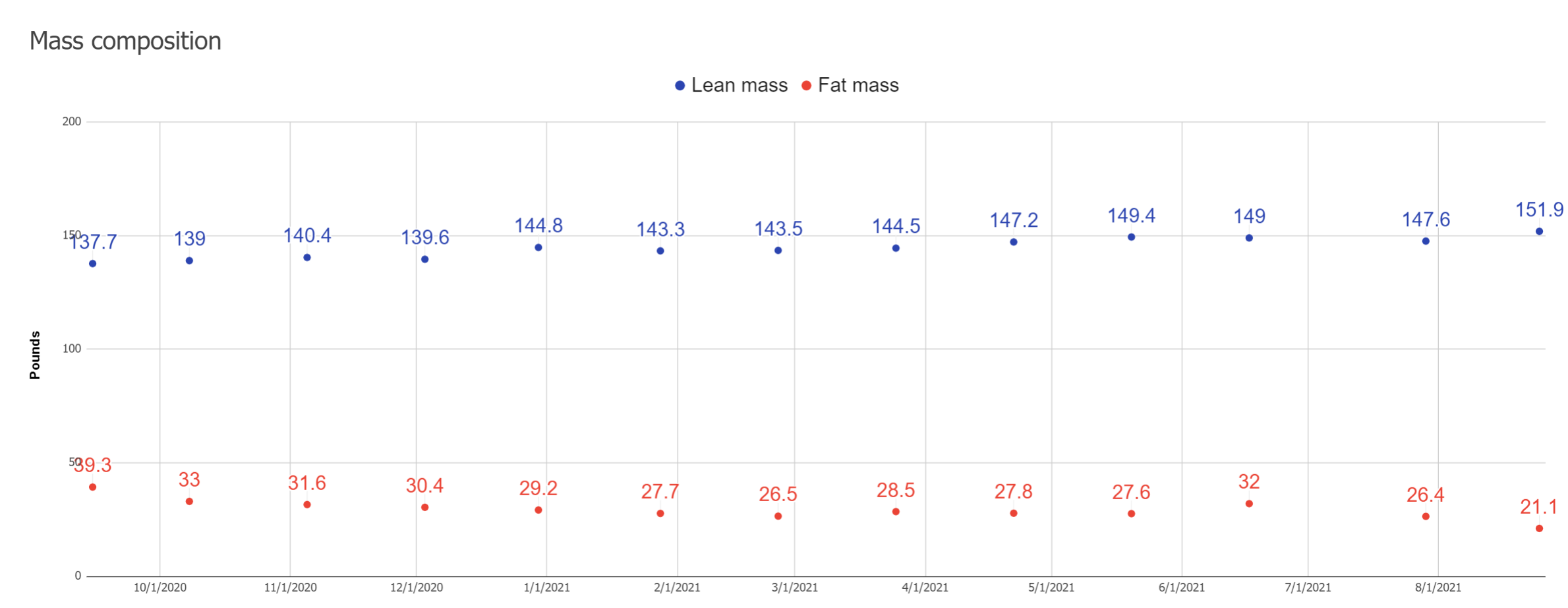
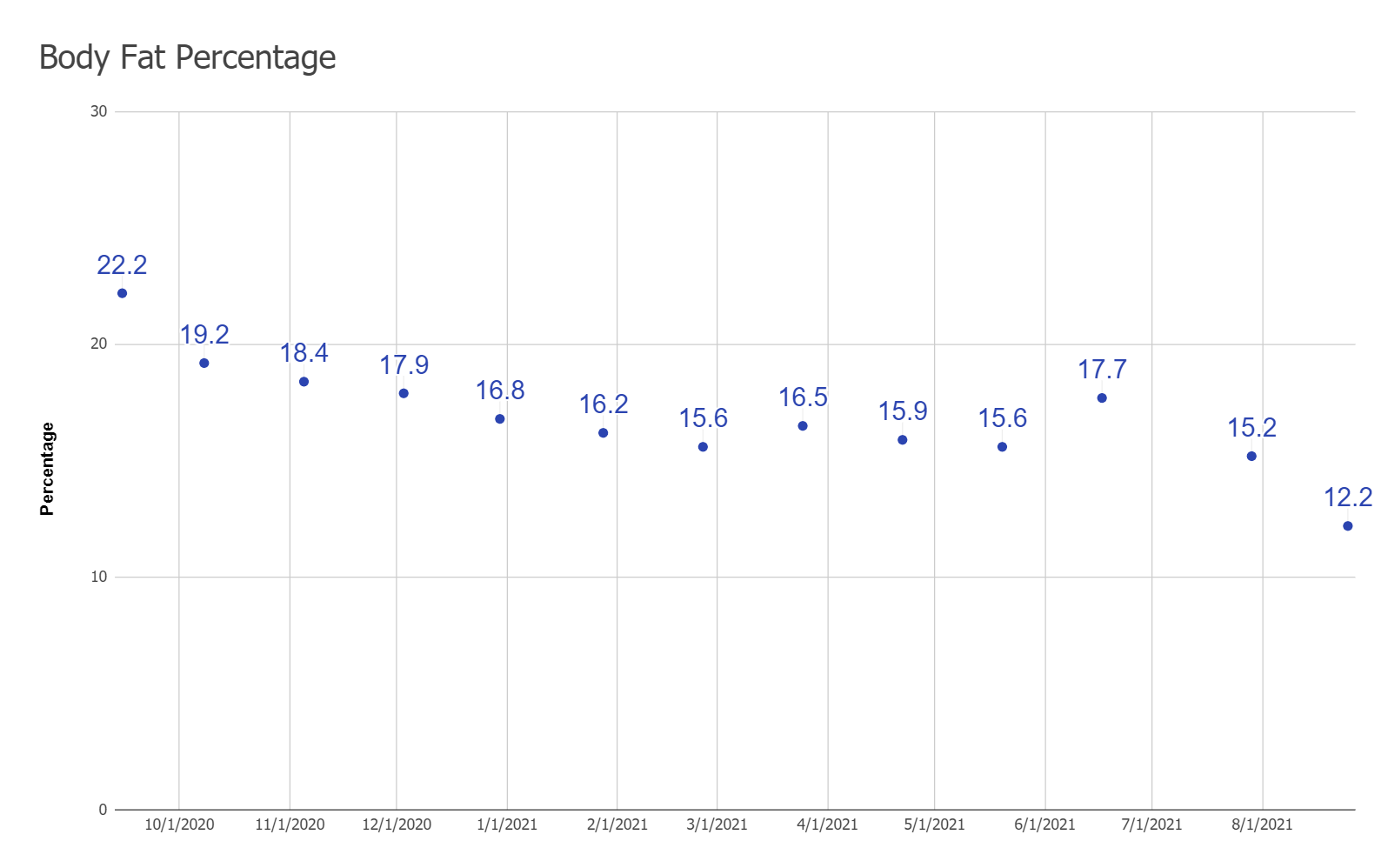
Bench Press
To bench I needed more active chest and triceps. The training plan had me doing every kind of pushup: wall, incline, decline, hold. I also found myself doing bent over rows, skullcrushers, tricep extensions, and lat pulldowns. The lat pulldowns especially helped me learn what it feels like to engage my lats. Keeping them engaged helped me stay tight for bench press.
I also didn’t just do straight bench. We did different inclines, bar shapes, grip spacings, and timed presses. The variance helped a ton.
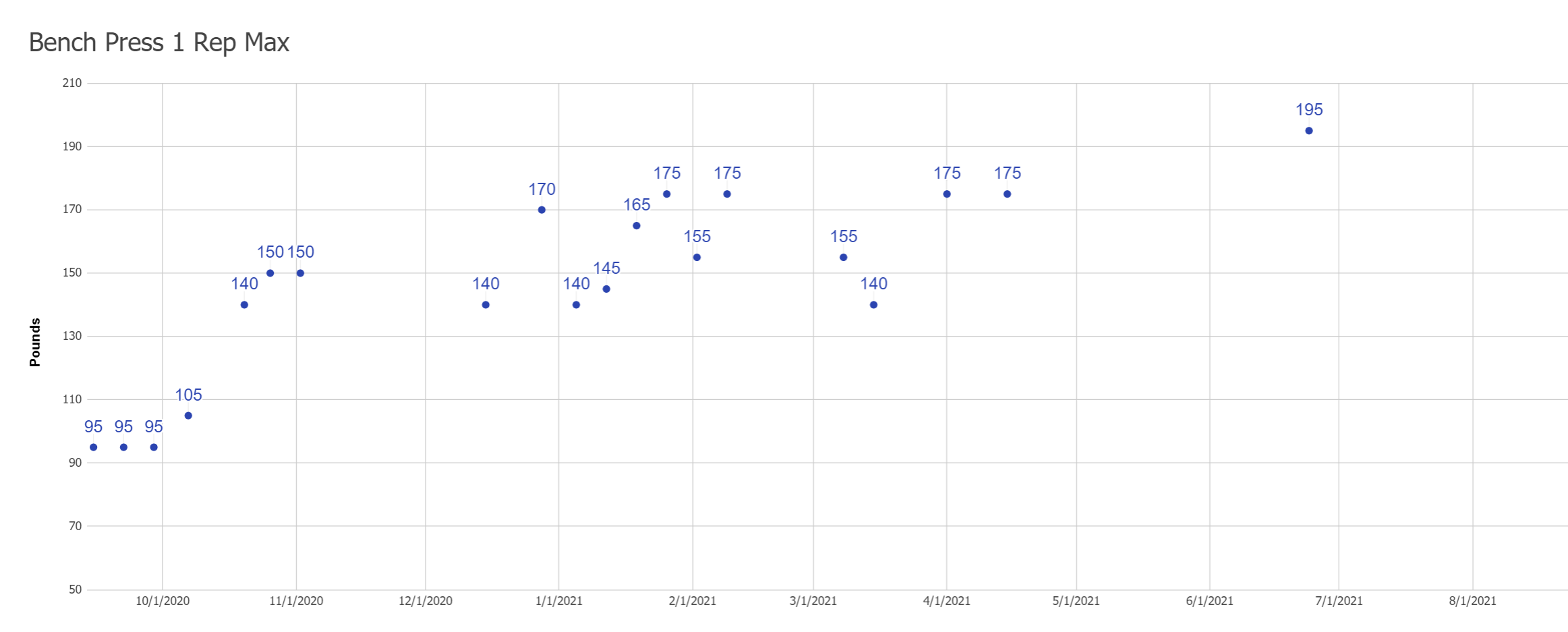
Bench Press 1 Rep Max from 2020 to 2021. Low of 95 pounds and personal best of 195 pounds.
Early on I struggled to keep form on bench. I would hit different spots on my chest, drop the bar too fast, flare my elbows a bit. After January I was starting to get the hang of it, but I had difficulty maxing out at the same time I was trying to push deadlift and squat. I am still happy to have learned the form.
Trap Bar Deadlift
For deadlift I tended to lean onto my toes, lose my bracing, and generally not keep a straight bar path.
To overcome this we spent months on strengthening my lats, hamstrings, and quads. We also did romanian deadlifts, banded deadlifts, bottom-half deadlifts, elevated deadlifts. Even some sumo and traditional deadlifts.
I was starting to get the form and hit higher weights.
In January I hit 410 pounds on deadlift and mentally plateaued. For the next 4 months I would come in, warm up to a heavy deadlift, get to 415 and not be able to lift it off the ground.
Jake never made me do a deadlift I couldn’t do, so we’d cut short as soon as my form slipped. Some days I couldn’t even get to 350. Those weeks tested me the most, and I tried chalk, straps, squat belt, and nothing seemed to help. I wanted to quit.
But I kept showing up. After weeks and weeks of failing I eventually broke the barrier and pushed to 430 and then 450. I felt over the moon.
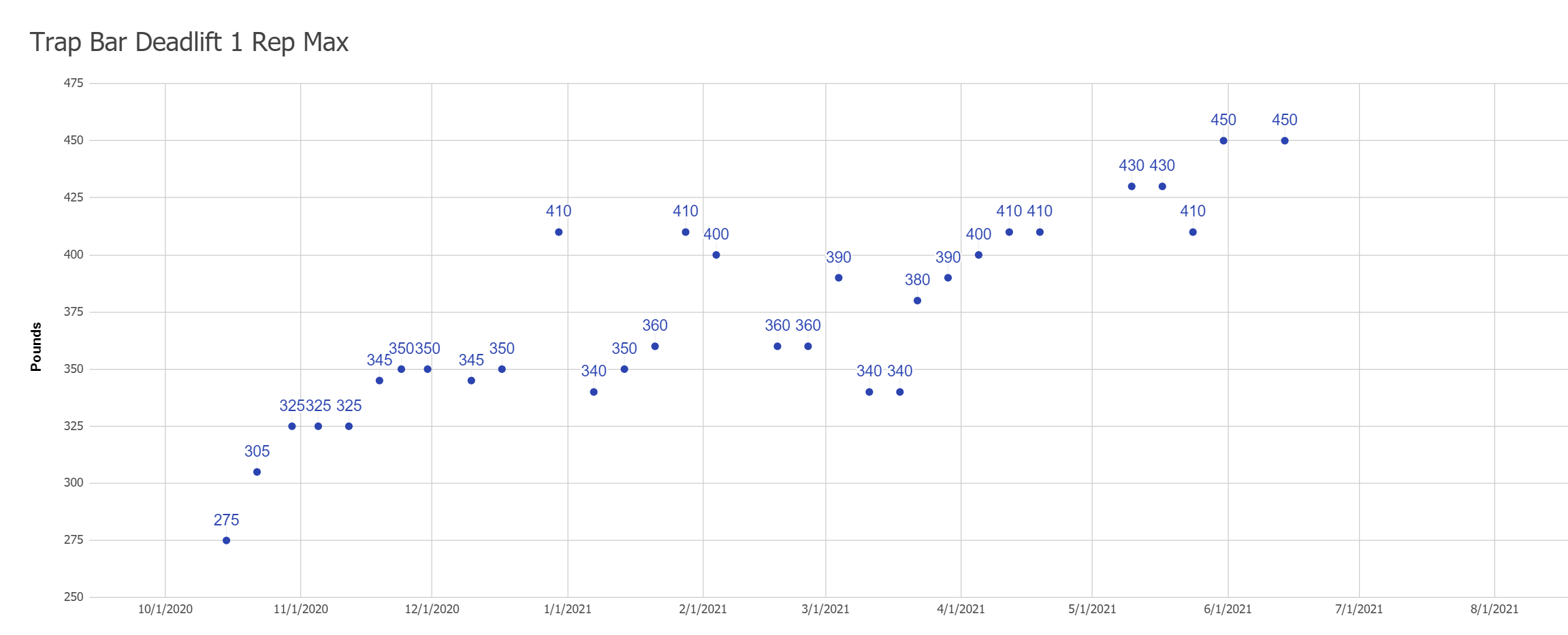
Trap Bar Deadlift 1 Rep Max from 2020 to 2021. Low of 275 pounds and personal best of 450 pounds.
Here’s an early 2020 video of me trying to deadlift followed by a video of the 450-pound deadlift:
Four seconds into the 450 video, you can hear and see me brace myself by breathing in, tightening my core, pulling my lats down, sitting back, and grabbing the ground with my feet. As I stand up I am driving my knees out and glutes forward. These tiny form details helped me tackle front and back squat.
Squats
When I started I could not do a single bodyweight squat without falling over. That same forward-leaning-on-my-toes tendency didn’t help. We worked on my ankle mobility and hip flexors while also mixing up the kinds of squats: hatfield, hack, timed. There was a lot of bodyweight squatting, walking lunges, split squats, quad extensions, and hamstring curls.
The variety, again, helped me hone the form and get stronger. We started with front squat and transitioned to back squat in the beginning of 2021. Out of all the movements I enjoyed back squats the most.
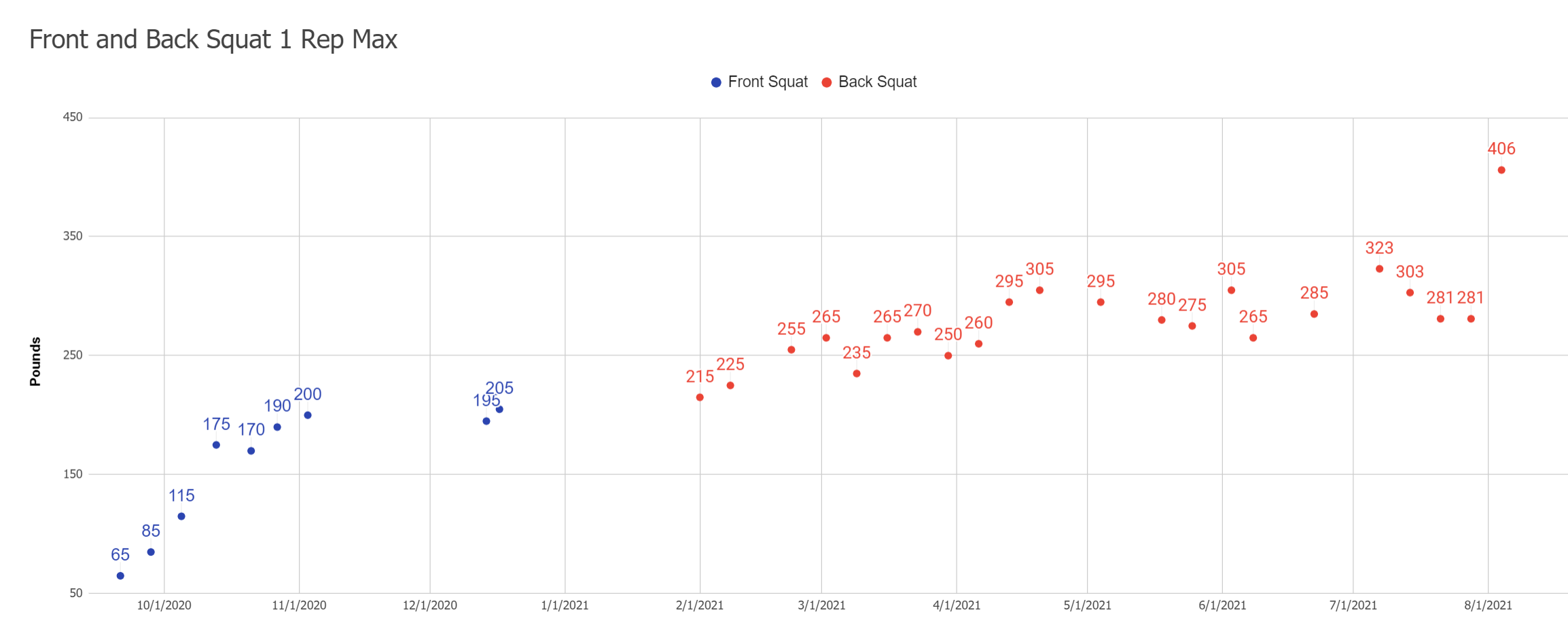
Front and Back Squat 1 Rep Max from 2020 to 2021. Low of 65 pounds on front and 215 pounds on back with respective personal bests of 205 pounds and 406 pounds.
The 406-pound personal best was a box squat, a variant where you let go of all elastic tension before standing up. Each side had 25 pounds in chains that pooled and became 0 pounds when at the bottom of the squat. At the top, the true weight was 456 pounds.
I breathed in, jammed myself into the bar while under it, and stood straight up. Then I took slow steps backward, angled my feet out for the squat, and rebraced. On the way down I am focused on grabbing the ground with my feet and driving my knees out. Same on the way up with the addition of firing my glutes, hamstrings, and quads as hard as I could. Even if I cannot move fast due to the weight I learned to always move with the intent of speed. There’s only so much fuel in the tank to “get out of the hole.”
Final stats
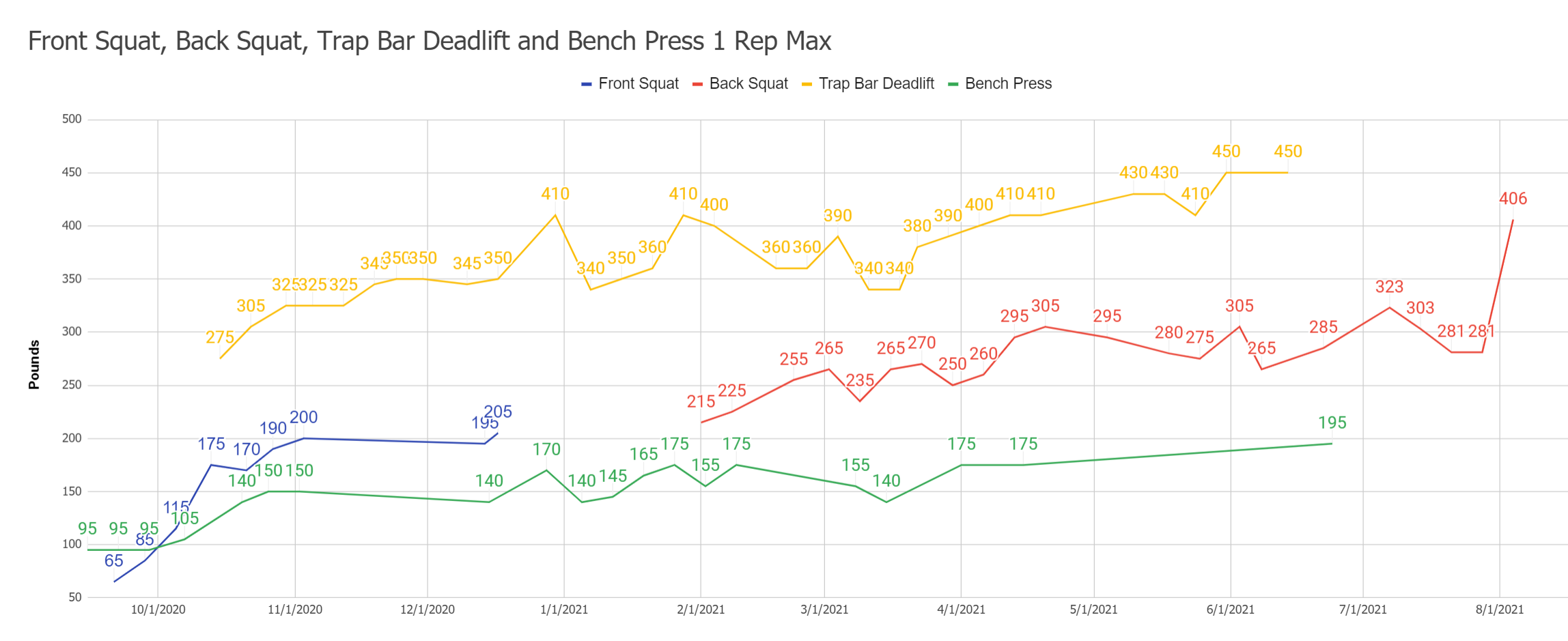
- Bench press: 95 pounds to 195 pounds (+100)
- Trap bar deadlift: 275 pounds to 450 pounds (+175)
- Front squat: 65 pounds to 205 pounds (+140)
- Back squat: 215 pounds to 406 pounds (+191)
What next?
I learned lifting, for me, is not as satisfying as running. I am returning to distance runs while lifting on the side for variance, balance, and general strength.
I feel much more comfortable in a gym now, and I am going to lift and train with my friends whenever they are up to it. I can’t wait to share everything I learned along the way.
To anyone considering lifting or another form of exercise, go for it. When it gets hard, just keep showing up. Eat the things and do the stuff.